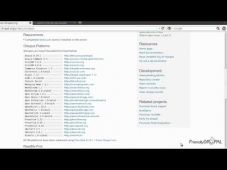

- #Drupal tutorial for developers how to#
- #Drupal tutorial for developers zip file#
- #Drupal tutorial for developers update#
- #Drupal tutorial for developers full#
- #Drupal tutorial for developers free#
Drupal uses the database to extract the data and enables to store, modify and update the database. It is used to store the administrative information to manage the Drupal site. You can use different types of web servers such as Apache, IIS, Nginx, Lighttpd, etc.ĭatabase − Database stores the user information, content and other required data of the site.

The communication between the user and the server takes place using HTTP. Weve gathered together a concise list of the Drupalize.Me tutorials, and other resources, that will help you prepare for Acquias Certified Drupal 9 Developer exam. Web Server − Web server is a server where the user interacts and processes requests via HTTP (Hyper Text Transfer Protocol) and serves files that form web pages to web users. The exam consists of 60 scenario-based questions about fundamental web development concepts, Drupal site building, theming, and back-end development. Drupal 6 requires at least 16MB, Drupal 7 requires 32MB and Drupal 8 requires 64MB. PHP memory requirements depend on the modules which are used in your site. It takes the help of web server to fetch data from the database. PHP − Drupal uses PHP in order to work with an application which is created by a user. Further, you will be able to handle complex forms and workflows. It is very easy to interact with other sites and technologies using Drupal CMS. Drupal CMS is very flexible and powerful and can be used for building large, complex sites. Rename the folder from its current name to any name of your choice to refer to your site.
#Drupal tutorial for developers zip file#
Step 1 Download the zip file and extract it to your local computer.
#Drupal tutorial for developers how to#
The following steps describe how to setup Drupal locally on your system.
#Drupal tutorial for developers free#
Administrative account will be having all privileges for managing content and administering the site.ĭrupal − Drupal is a free and open source Content Management System (CMS) that allows organizing, managing and publishing your content and is built on PHP based environments. Its very easy to setup Drupal on your system. acts like clients.Īdministrator − Administrator can provide access permission to authorized users and will be able to block unauthorized access. The user sends a request to a server using Drupal CMS and web browsers, search engines, etc.

Users − These are the users on the Drupal community. The architecture of Drupal contains the following layers &miuns The following diagram shows the architecture of Drupal − In this chapter, we are going to discuss the architectural style of Drupal for implementing user interfaces. Before saving the details, you can also preview the filled page using the Preview button.Drupal is a platform for web content management which is a powerful tool for building simple and complex sites. You'll need PHP and Composer, and then can run these two commands: composer create-project drupal/recommended-project drupal & cd drupal php -d memorylimit256M web/core/scripts/drupal quick-start. Click the Save button to create the page. To help you get up to speed, the community has curated expert documentation to help you get started. Once you complete adding the content to the page. Publishing options − It specifies that the page should be Published, Promoted to front page and Sticky at top of lists for the users. URL path settings − It specifies to add URL alias to access the content of pages to the users.Ĭomment settings − By selecting open or close, it allows displaying a comment box for the page.Īuthoring information − It specifies the authored name and the date when page has been authored. Revision information − It specifies to provide revise information, if any changes are made in the pages. Refer to 50 Drupal Tips and Tricks Drupal 6 Theme Guide - If you want to get started with drupal themes, this is the right tutorial to start with. Menu settings − By clicking on checkbox Provide a menu link, it shows the details of Menu such as Menu link title, Description, Parent item, and Weight. Once you have got started and have your websites up.
#Drupal tutorial for developers full#
Text format − It specifies the Text format for your page such as Filtered HTML, Full HTML, and Plain text. Title − It specifies the title for new page.īody − It specifies the description of the page. Step 4− Create Basic page will get displayed where you need to fill all the required details as shown in the following screen.įollowing are the details of the fields present on Create Basic page. Step 2− Click on Add content as shown in the following screen. It is very easy to create pages in Drupal.įollowing are the simple steps used to create pages in Drupal. In this chapter, we will study about how to Create Pages in Drupal.


 0 kommentar(er)
0 kommentar(er)
